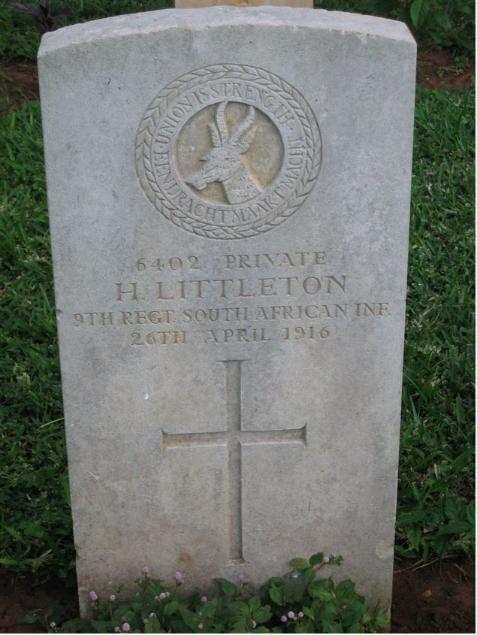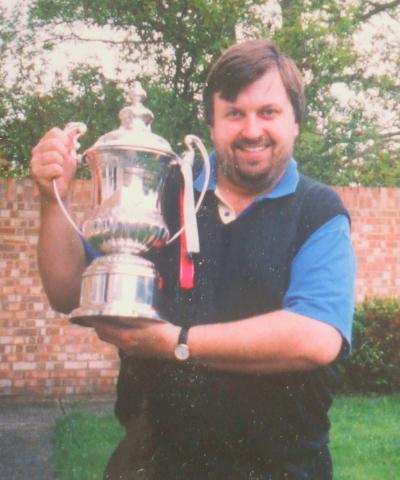Lest We Forget: In Memory of Maidenhead and Maidenhead Norfolkians Players Who Lost Their Lives in The Two World Wars Part One: First World War
07/10/2022 - 12.23
Mark Smith and Matthew Shaw
This is the first in a series of articles that commemorates the lives of Maidenhead and Maidenhead Norfolkians players who made the ultimate sacrifice in World War One and World War Two, based on the Maidenhead United FC match day programme series entitled Lest We Forget.
Herbert Hedges Barford
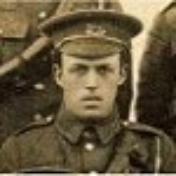
Source: Wayne Ratcliffe
Herbert Hedges Barford was born on 25th June 1887, the son of Joseph Hedges Barford, an Assistant Surveyor, and Ellen Barford (née Stannent) of 20 Kings Grove, Maidenhead. He was educated at Maidenhead Boys School (now Desborough) in Shoppenhangers Road. Herbert was a Civil Servant before joining the Army and was engaged to a Miss Daisy Skinner of Hinckley. Herbert was a member of “A” Squadron, 4th Troop, 1st Berkshire Yeomanry and played for the Reserves in the 1911/12 season.
The Berkshire Yeomanry were mobilised on 5th August 1914 and spent the first months of the war training in Berkshire and Norfolk before leaving for Egypt in April 1915.
In August of that year, the 2nd South Midland Mounted Brigade (which included the 1/1st Berkshire Yeomanry) was ordered to Gallipoli. That campaign had begun in April 1915, as a purely naval enterprise designed to take control of the area known as the Dardanelles but became a full scale Anglo-French led invasion of the Gallipoli Peninsula with a second major offensive launched in August 1915.
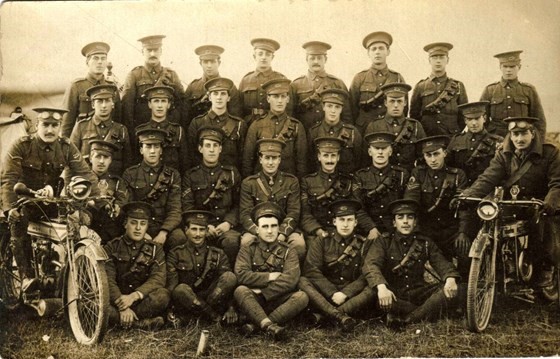
4th (Maidenhead) Troop of 'A' Squadron. Source: Berkshire Yeomanry Website
On August 21st, the Berkshire Yeomanry, who had only arrived three days beforehand, were tasked with specifically taking control of Scimitar Hill from the Ottomans, one of several hills in the immediate vicinity of strategic importance. The operation involved three British Divisions and was timed to commence at 3.00pm to take advantage of a setting sun that would be shining in the eyes of the Turkish positions but by the time the Yeomanry arrived on the scene, after a march across a dry salt lake on the Suvla plain, the sun had disappeared and a veil of haze arose from the plain which soon thickened to a smog. The Yeomanry were faced with the task of capturing positions they could barely see but, despite the confusion, they launched their attack just after 6.00pm. They stormed the crest but they were beaten back by machine-gun fire emanating from their front and flanks which tore through the ranks. In the chaos of abandoning the summit, many seriously wounded men remained on the hill trapped in a no-man’s land surrounded by burning shrub and furious cross fire.
The Berkshire Yeomanry had been on the peninsula for just three days and the attack on Scimitar Hill was their first operation. Led by Major E. S. Gooch, the regiment had gone into action with nine officers and 314 men. By nightfall, only four officers and 150 men remained. Herbert Hedges Barford was one of those killed.
Known Reserve team appearances = 6 (would have been more but detailed information unavailable)
Presumed Debut - 30th September 1911 at Wycombe Trinity (South Bucks and East Berks League)
Presumed Final appearance - 9th December 1911 v Chalvey (Berks and Bucks Junior Cup)
Walter George Folley
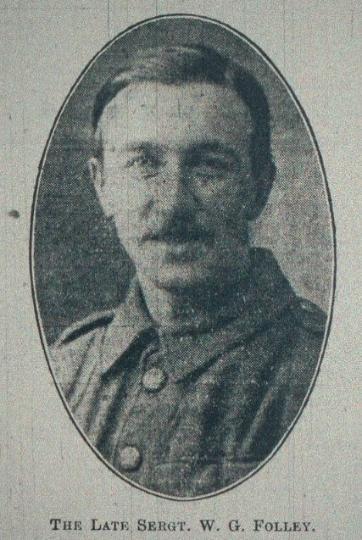
Source: Maidenhead Advertiser
Walter George Folley was born in 1895 and was the second son of William and Jane Folley (née Fletcher) of 6 Park Street, Maidenhead. He attended Gordon Road school where he was described as “…honest, straightforward and hard-working in school and plucky and good-tempered in games and was popular with teachers and fellow pupils alike and was considered a respectable well-conducted young man”. He assisted his father in his business as a builder, decorator and plumber and regularly played football with his brother William, for North Town Football Club in the South Bucks and East Berks League but when North Town FC folded at the end of 1911/12 season, seven players including Walter joined Maidenhead FC, whilst also assisting other local junior clubs. Walter played for Maidenhead Norfolkians, making one 1st team appearance against the 3rd Coldstream Guards on 30th November 1912, and made seven known appearances for their Reserve side in 1913/14 season.
Walter was a regular attendee at the Maidenhead Primitive Methodists Church and was a devoted and energetic worker in both Church and Sunday school and collected useful amounts annually for the Dr. Barnardo’s Homes and other charitable institutions.
Walter enlisted in 1914, at the Recruiting Office in Reading and when Walter was asked where he was prepared to serve, he replied “…where my country needs me most”. He became a keen soldier and on arriving at France with the 8th Battalion of the Royal Berkshire Regiment, he was soon in the trenches where he remained for a year. Walter discharged his duties with such conspicuous ability that he was promoted to Sergeant of the Machine Gun section, but he had previously had a very narrow escape as a result of shell fire when, whilst with his uncle, he was buried in a trench from which they were both dug out although his uncle was badly injured.
Tragically, Walter was killed in action on the night of September 1st 1916. His section, of which he was the Sergeant-in-charge, was in support and progressing through Mametz Wood in France a little way back from the front line at the time. However, the wood came under heavy shelling and one shell dropped into a trench where he and a comrade were sheltering and they were both killed instantly.
Walter was laid to rest by his colleagues in a small plantation a little to the east of Mametz Wood and was eventually interred nearby in Flatiron Copse. The ground had been taken on 14th July 1916 and an Advance Dressing Station was established at the copse. Walter’s brother, William, was serving as a private with the R.A.M.C and was awarded a Military Medal during World War One.

Walter’s headstone in Flatiron Cemetery. Source: Berkshire Yeomanry Website
Known Reserve team appearances = 4, 1 goal (but our records are decidedly incomplete)
Presumed Debut – 14th September 1912 v Wycombe All Saints (South Bucks and East Berks League)
Presumed Final appearance – 23rd November 1912 v Wycombe All Saints (Maidenhead Norfolkian Cup)
George Henry Thomas Gibson
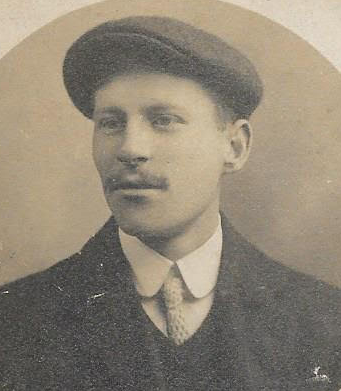
Source: Pauline Jones (Family)
George Henry Thomas Gibson was born in Maidenhead in 1881, the son of George Gibson and Annie Beard (born 1858, died 1899). George’s father then married Elizabeth Clements and the family resided at 23 Moffatt Street. George had three brothers – William, Frederick and Harold, one sister Daisy, then two step-sisters, Daisy and Eva, and three step brothers, Ernest, Henry and Albert.
George was educated at East Street School and he and his father both worked as bricklayers with George Senior working on the construction of Brunel’s Sounding Arch Bridge over the River Thames in Maidenhead.
George began his footballing career with Maidenhead in 1901/02 season playing initially as an outfield player on the left wing. Our records are decidedly incomplete although it is known he scored two goals in 1902/03 season. By the time George featured for the 1st team, from 1906, he was a goalkeeper and remained in that position until the outbreak of World War One, earning many accolades about his goalkeeping prowess and ability in the local paper. He represented the Berks and Bucks FA, and played for the Great Western Suburban League Representative side against the London League XI at Stamford Bridge in January 1911. He was a member of the Maidenhead team that won the Berks and Bucks Cup in 1912 (defeating Aylesbury United 2-0 at Wycombe) and the Oxford Hospital Cup in 1913 (defeating Slough 1-0 at York Road), before joining Windsor and Eton in the summer of 1913. However, George returned to Maidenhead in November and remained 1st choice goalkeeper for the rest of the season. In the home Berks and Bucks Cup tie against “G Company” Royal Berkshire Regiment on 4th December 1909, Maidenhead were so dominant (they won 12-0) that George wore an overcoat for a large part of the game to keep warm and eventually switched positions with a forward.
George volunteered for service and joined the Royal Berkshire Regiment at the outbreak of World War One and was then in the Hertfordshire Regiment before becoming a member of the 1st Battalion, Bedfordshire Regiment. He was a Territorial and whilst with the Battalion, in 1915, he was stationed in Chelmsford and played for the Regiment in a friendly fixture against Chelmsford Football Club.
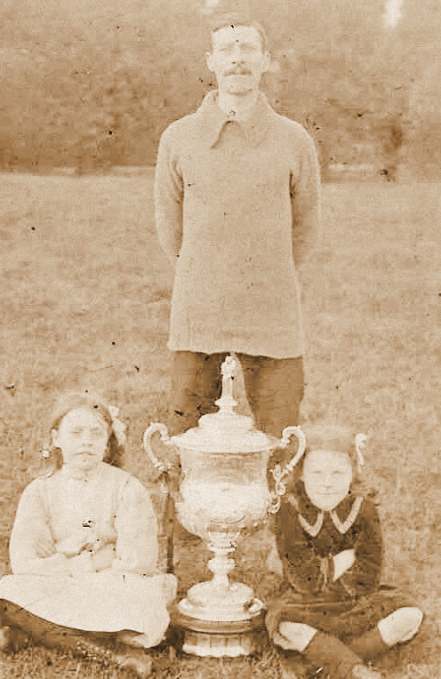
George with the Oxford Hospital Cup and step-sisters, Daisy and Eva. Source: Pauline Jones (Family)
Unfortunately, very little is known of George’s precise military record but it is thought that he could have been a member of the Army Cycling Corps and, just before his death, in early September 1918, the 1st Battalion, Bedfordshire Regiment were fighting on the front line in the Fremicourt/Beugny area of France. During an attack on the 3rd September 1918, the Battalion suffered some casualties with nine men reported as wounded, one of which, it can be speculated was possibly George. Despite the fact that the Allied forces were advancing through France at a rapid rate, the following day (4th September) the Battalion was withdrawn from the front line until after George's death. The Casualty Clearing Stations in the vicinity – the 3rd, 29th, 45th and 56th, were based in the Gezaincourt area, thirty-one miles away from Fremicourt, so there is a likelihood that if George was one of those injured, he was evacuated down the line to one of the clearing stations where he died from his wounds on 6th September. He is buried in the Bagneux British Cemetery in Gezaincourt.
Known 1st team appearances = 178 (but our records are incomplete)
Presumed Debut – 15th December 1906 at Chesham Town (Berks and Bucks Cup)
Presumed Final appearance – 23rd April 1914 v Maidenhead Norfolkians (Great Western Suburban League)
Member of the team that won the Berks and Bucks Cup in 1912 and the Oxford Hospital Cup in 1913.
Known Reserve team appearances = 14 (but our records are decidedly incomplete)
Presumed Debut – 1st March 1902 v Burnham (friendly)
Presumed Final appearance – 1st February 1907 v Wycombe Trinity (South Bucks and East Berks League)
Henry (Harry) Littleton

Source: Steve Rolls
Henry Littleton was born in 1876, the son of George and Mary Littleton (née White). Henry had six brothers – George, Frank, Charles, Ernest, Alfred Edgar and Walter and three sisters, Alice, Kate and Mary. The family lived at 13 Norfolk Park Cottages but from an early age Henry was known as Harry and he became a carpenter and joiner.
Harry played football for the Maidenhead Norfolkians in 1899/1900 (eight appearances) and 1901/02 (seven appearances) and for Maidenhead Football Club, initially playing for the “Red and Blacks” Reserve team between 1896 and 1898, and then the 1st team between November 1901 and April 1902, when Maidenhead and the Maidenhead Norfolkians had agreed a “co-operative” scheme to assist each other, although this arrangement only lasted one season.
The war in East Africa was a war of mobility and guerrilla tactics containing hundreds of skirmishes and lightning quick battles, which could involve marches of hundreds of miles through sweltering jungles, cool highlands and terrain that quickly turned to swamps following torrential downpours. Harry Littleton was part of the 9th Regiment, South African Infantry, led by Field Marshal Jan Smuts, whose preferred method of combat was flanking movements rather than direct frontal combat. The enemy German forces consisted predominantly of local colonials who were far more capable of surviving the tropical illnesses, commanded by German NCO’s.
In February 1916, Smuts took command of the Allied Forces in East Africa in need of success following defeats at Gallipoli, Loos and Mesopotamia, whilst Paul von Lettow-Vorbeck was the German commander. In March 1916, Smuts British and South African forces surrounded German forces at Kahe, south of Kilimanjaro, but the enemy had taken strong defensive positions and inflicted heavy casualties before withdrawing.
After the Battle of Kahe, a detachment of troops (including Harry) was sent south under the command of Lieutenant-General Jacob Van Deventer (South African Overseas Expeditionary Force) to capture the Central Railway. They won a small victory at Lolkisale, but lost half their troops to disease having been slowed by rain and mud and also lost half of their horses and mules to tsetse fly. It is known that the remainder of the detachment of troops reached the Mission Hospital at Ufiome on April 12th 1916. It is feasible to assume that Harry Littleton was almost certainly sick with bacterial food poisoning (ptomaine) by this time and died there a fortnight later aged 40. He was buried in the Dar es Salaam War Cemetery in Tanzania.
Henry's headstone in the Dar es Salam Cemetery. Source: Maidenhead Advertiser
Known 1st team appearances = 7, 1 goal (but our records are incomplete)
Presumed Debut – 16th November 1901 at Southall (Southern League)
Presumed Final appearance – 5th April 1902 at Grays United (Southern League)
Known Reserve team appearances = 16 (but our records are decidedly incomplete)
Presumed Debut – 21st November 1896 v Maidenhead Norfolkians (Berks and Bucks Junior Cup)
Presumed Final appearance – 8th April 1898 v Maidenhead Norfolkians (South Bucks and East Berks League)
Additional Information and Sources
Berkshire Yeomanry Museum website.
Steve Hawkes
Pauline Jones
Ken and Christine Nelms
Lesley Norris
Wayne Ratcliffe
Steve Rolls
Biographies
Mark Smith attended his first Maidenhead match in March 1976 and continued to watch games fairly regularly for the next forty years. He was responsible for producing the club’s first ever “Handbook” in 1978, and has researched and chronicled the club’s history ever since. He was responsible for organising five exhibitions on the club, two at Maidenhead Library and three at the Maidenhead Heritage Centre (“The Magpies Story”). He has also written four books – Maidenhead FC 1870 – 1914; Maidenhead United 1919 – 1995; Maidenhead United 1995 - 2005, and, to coincide with the club’s 140th anniversary, published a 352-page detailed history entitled “One for Sorrow, Two for Joy” in 2011.
Aside from writing many series for the match programme (such as “Past Maidenhead Greats” and “An A-Z of Maidenhead United”) together with standalone articles, Mark also compiled “One of the Fifteen” on the fifteen players who appeared in the first ever Maidenhead FC match in December 1870, and “Lest We Forget” on those associated with Maidenhead FC and Maidenhead Norfolkians who lost their lives during the two World Wars. He also arranged to have the Maidenhead United Heritage website created - www.mufcheritage.com in 2009.
Matthew Shaw has played for several local football teams and became interested in the history of local football as members of his family have always been involved in football in the Berks and Bucks Counties as far back as the 1870s.
When researching family involvement in clubs in the combined counties, Matthew focused on pre First World War local football and the impact the war had on local teams.
Matthew has researched the Maidenhead Norfolkians FC in depth and helped the Maidenhead United FC Historian Mark Smith on all things Norfolkians. This meant he was also greatly involved in Mark's series "Lest We Forget" that was featured in Maidenhead United home programmes, as Matthew had already researched a large number of the town's footballers from both Senior and Junior clubs who had lost their lives in the Great War.
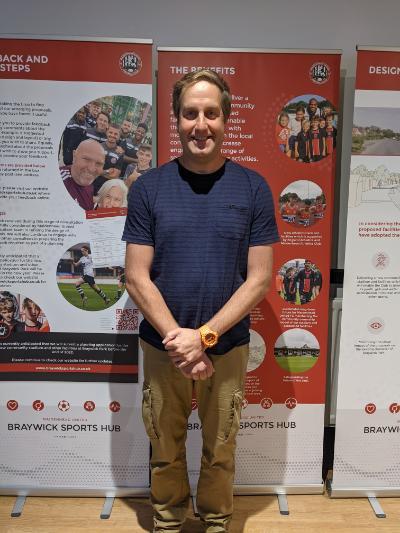


/prod01/wlvacuk/media/departments/digital-content-and-communications/images-2024/Diane-Spencer-(Teaser-image).jpg)
/prod01/wlvacuk/media/departments/digital-content-and-communications/images-18-19/220325-Engineers_teach_thumbail.jpg)
/prod01/wlvacuk/media/departments/digital-content-and-communications/images-2024/240509-Menopause-Research-Resized.jpg)
/prod01/wlvacuk/media/departments/digital-content-and-communications/images/Maria-Serria-(teaser-image).jpg)
/prod01/wlvacuk/media/departments/digital-content-and-communications/images-2024/241014-Cyber4ME-Project-Resized.jpg)
/prod01/wlvacuk/media/departments/digital-content-and-communications/images-2024/240315-Research-Resized.jpg)
/prod01/wlvacuk/media/departments/digital-content-and-communications/images-2024/BDA-group-photo.jpg)
